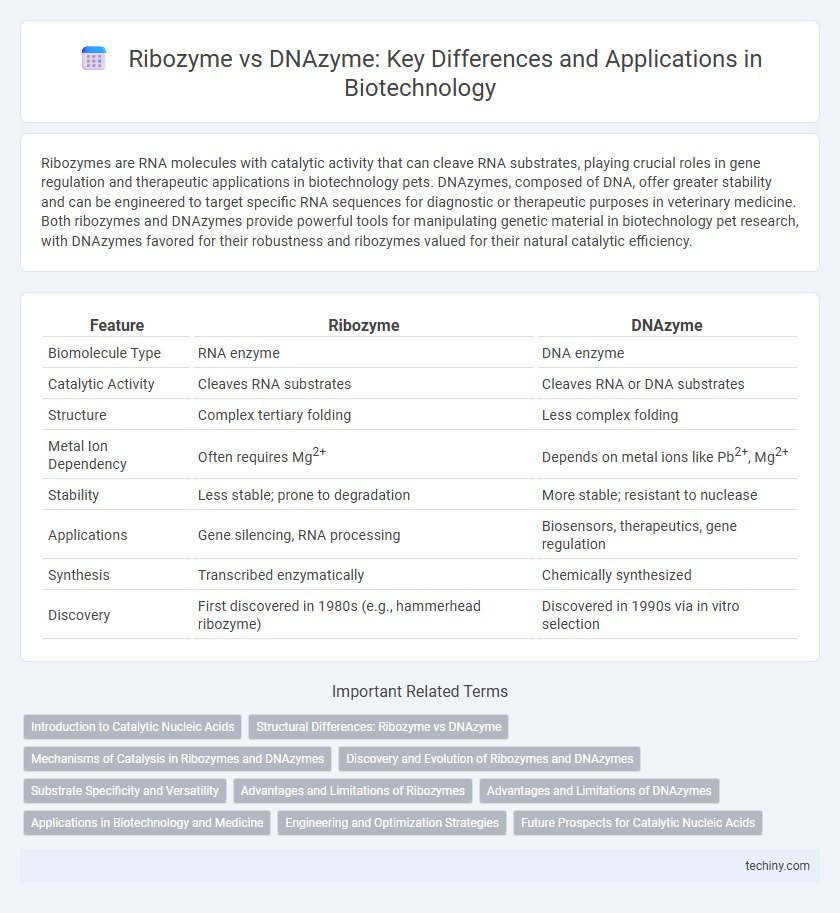Ribozymes are RNA molecules with catalytic activity that can cleave RNA substrates, playing crucial roles in gene regulation and therapeutic applications in biotechnology pets. DNAzymes, composed of DNA, offer greater stability and can be engineered to target specific RNA sequences for diagnostic or therapeutic purposes in veterinary medicine. Both ribozymes and DNAzymes provide powerful tools for manipulating genetic material in biotechnology pet research, with DNAzymes favored for their robustness and ribozymes valued for their natural catalytic efficiency.
Table of Comparison
| Feature | Ribozyme | DNAzyme |
|---|---|---|
| Biomolecule Type | RNA enzyme | DNA enzyme |
| Catalytic Activity | Cleaves RNA substrates | Cleaves RNA or DNA substrates |
| Structure | Complex tertiary folding | Less complex folding |
| Metal Ion Dependency | Often requires Mg2+ | Depends on metal ions like Pb2+, Mg2+ |
| Stability | Less stable; prone to degradation | More stable; resistant to nuclease |
| Applications | Gene silencing, RNA processing | Biosensors, therapeutics, gene regulation |
| Synthesis | Transcribed enzymatically | Chemically synthesized |
| Discovery | First discovered in 1980s (e.g., hammerhead ribozyme) | Discovered in 1990s via in vitro selection |
Introduction to Catalytic Nucleic Acids
Catalytic nucleic acids, including ribozymes and DNAzymes, are RNA and DNA molecules that possess enzymatic activity, enabling them to catalyze specific biochemical reactions. Ribozymes naturally occur in cells and primarily facilitate RNA cleavage, whereas DNAzymes are synthetic molecules engineered in vitro with diverse catalytic functions. Understanding the structural and functional distinctions between ribozymes and DNAzymes is crucial for advancing applications in gene regulation, molecular diagnostics, and therapeutic development.
Structural Differences: Ribozyme vs DNAzyme
Ribozymes and DNAzymes differ significantly in their structural composition; ribozymes are RNA molecules with complex three-dimensional folds formed through intramolecular base pairing, enabling catalytic activity. DNAzymes, in contrast, are single-stranded DNA enzymes typically possessing simpler secondary structures but require metal ion cofactors such as Mg2+ or Pb2+ to facilitate catalysis. The inherent chemical variability of ribose sugars and 2' hydroxyl groups in ribozymes contributes to greater conformational diversity compared to the more rigid deoxyribose backbone of DNAzymes.
Mechanisms of Catalysis in Ribozymes and DNAzymes
Ribozymes catalyze reactions through RNA's unique folding patterns that position functional groups to facilitate phosphodiester bond cleavage or ligation, relying on metal ions like Mg2+ for stabilization and catalysis. DNAzymes utilize similar mechanisms, harnessing their DNA backbone and metal cofactors, often Pb2+ or Mg2+, to perform site-specific cleavage of RNA substrates via nucleophilic attack. Both ribozymes and DNAzymes exemplify nucleic acid-based catalysis but distinctively depend on their structural conformations and metal ion cofactors to achieve precise biochemical transformations.
Discovery and Evolution of Ribozymes and DNAzymes
Ribozymes, discovered in the early 1980s by Thomas Cech and Sidney Altman, revolutionized molecular biology by revealing RNA's catalytic capabilities, supporting the RNA world hypothesis for early molecular evolution. DNAzymes, identified in the 1990s through in vitro selection techniques, expanded catalytic nucleic acid research by demonstrating DNA's ability to perform enzyme-like activities despite DNA's primary role as genetic material. Both ribozymes and DNAzymes have evolved through natural selection and laboratory engineering, driving advances in gene regulation, therapeutic development, and synthetic biology.
Substrate Specificity and Versatility
Ribozymes exhibit high substrate specificity by catalyzing reactions primarily involving RNA molecules, enabling precise cleavage and ligation within targeted RNA sequences. DNAzymes, in contrast, demonstrate greater versatility by catalyzing a broader range of chemical reactions, including RNA cleavage and DNA modifications, due to their diverse sequence designs. This difference in substrate specificity and catalytic scope underpins the distinct applications of ribozymes in RNA-targeted therapeutics and DNAzymes in biosensing and chemical biology.
Advantages and Limitations of Ribozymes
Ribozymes, catalytic RNA molecules, offer specificity in cleaving RNA sequences, making them valuable tools for targeted gene regulation in biotechnology and therapeutic applications. Their ability to catalyze reactions without the need for protein enzymes presents an advantage over DNAzymes, which often require metal ions for activity. However, ribozymes face limitations such as lower stability in vivo due to susceptibility to nucleases and challenges in efficient cellular delivery compared to DNAzymes.
Advantages and Limitations of DNAzymes
DNAzymes offer high catalytic efficiency and specificity in cleaving RNA substrates, making them valuable tools for targeted gene regulation and therapeutic applications. They exhibit greater chemical stability and resistance to degradation compared to ribozymes, enhancing their performance in biological systems. However, DNAzymes face limitations such as restricted substrate scope and dependence on specific metal ion cofactors, which can affect their versatility and in vivo functionality.
Applications in Biotechnology and Medicine
Ribozymes catalyze RNA cleavage and splicing, enabling precise gene regulation and therapeutic RNA targeting in diseases like viral infections and cancer. DNAzymes offer enhanced chemical stability and specificity, making them effective in biosensors, targeted gene silencing, and drug delivery systems. Both enzymes advance biotechnology by enabling novel RNA manipulation techniques and selective molecular interventions with potential for personalized medicine.
Engineering and Optimization Strategies
Ribozymes and DNAzymes are engineered through directed evolution and rational design to enhance catalytic efficiency and substrate specificity in biotechnology applications. Techniques such as mutagenesis, high-throughput screening, and computational modeling optimize their structural stability and functional activity under physiological conditions. Advanced methods including SELEX (Systematic Evolution of Ligands by EXponential enrichment) refine binding affinity and catalytic turnover, enabling precise control over gene regulation and molecular diagnostics.
Future Prospects for Catalytic Nucleic Acids
Ribozymes and DNAzymes continue to revolutionize biotechnology with their unique catalytic properties and programmability, offering promising applications in gene therapy, diagnostics, and synthetic biology. Advanced engineering of catalytic nucleic acids enhances their stability, specificity, and catalytic efficiency, paving the way for innovative therapeutic strategies targeting previously undruggable diseases. Emerging technologies integrating ribozymes and DNAzymes with nanomaterials and CRISPR systems are driving the development of highly precise and controllable molecular tools for future biomedical interventions.
Ribozyme vs DNAzyme Infographic

 techiny.com
techiny.com